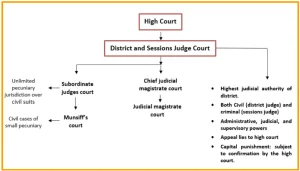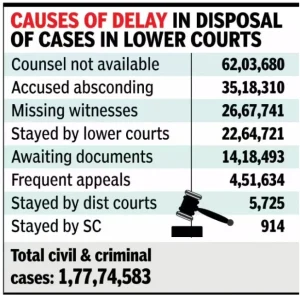A recent Constitution Bench of the Supreme Court of India observed that stagnation in the subordinate judicial service contributes to prolonged litigation and adds to the huge pendency in India’s courts
About the Indian Lower Judiciary
- Regulatory Framework: Articles 233 to 237 in Part VI of the Constitution provide for the organisation and control of the subordinate judiciary
- Recruitment is conducted as per rules framed by the State Government in consultation with the High Court, while posting, promotion, and disciplinary control over subordinate judges substantially vest in the High Court under Article 235.
- District Judges (Article 233): Appointed, posted, and promoted by the Governor in consultation with the High Court.
- Qualifications:
- Not in service of the Union/State.
- Advocate/Pleader for 7 years.
- Must be recommended by the High Court.
- Other Judicial Appointments (Article 234): Appointed by the Governor in accordance with rules framed after consulting the State Public Service Commission and the High Court.
- Specialised subordinate courts such as Commercial Courts, Family Courts, and courts of Judicial Magistrates also function within the same constitutional framework, subject to specific statutes.
- Administrative Control
- Control over Subordinate Courts (Article 235): High Court manages district and lower courts, overseeing transfers, promotions, and leave of officers below district judge rank.
- Interpretation of ‘District Judge(Article 236)’: Includes city civil court judges, sessions judges, and chief magistrates.
- Judicial Service includes posts below district judges.
- Hierarchy of Subordinate Courts in India
- Judicial Structure and Jurisdiction: Varies by state with three tiers of courts below the High Court.
- It typically includes the District and Sessions Court at the apex, followed by courts of Subordinate Judges and Chief Judicial Magistrates (CJM) in the middle tier, and the lowest tier containing courts like the Munsif or Judicial Magistrate
- District Judges (civil) and Sessions Judges (criminal) hold appellate and original jurisdiction.
- Powers:
- District Judges: Handle civil and administrative matters; appeals go to the High Court.
- Sessions Judges: Can impose life imprisonment or capital punishment, subject to High Court confirmation.

Metropolitan and Other Courts
- City Civil Courts: Handle civil cases in metropolitan areas.
- Metropolitan Magistrates’ Courts: Deal with criminal cases.
- Small Cause Courts: Summary decisions on minor civil cases (High Court has revision power).
- Panchayat Courts: Handle petty civil and criminal cases, known by various local names.
|
Reason for Judicial Pendency in Subordinate Courts
Scale of Pendency
- 5.34 crore cases pending across all courts (as of Sept 25)
- 4.7 crore pending in district & subordinate court
- 63.8 lakh in High Courts; 88,251 in Supreme Court.
|
- Acute Judge Shortage & High Vacancy Rates: District courts suffer from large vacancies and low judge–population ratio (21 per million vs 50 recommended).
- Despite being the first tier for most of all cases, sanctioned posts remain unfilled, slowing trials and amplifying backlog.
| “Three-adjournment Rule”
It mandates that no case should be granted more than three adjournments during its entire lifecycle, except for exceptional and justified circumstances. |
- Excessive Adjournments & Inefficient Case Management: Over 50% of cases violate the “three adjournments” rule. Morning “call work” in trial courts often extends till noon, leaving limited time for evidence, arguments, or final orders.
- Heavy Administrative Burden on Judges: Subordinate judges spend 10:30 a.m. to noon calling cases, issuing summons, checking appearances, and receiving vakalatnamas; losing valuable judicial time needed for hearings and judgments.
India Spend On Judiciary
- Most states spend less than 1% of their annual budget on the judiciary, whereas the Union government allocated just 0.07% in 2025-26.
- Overall, India spends only 0.14% of its GDP on the judiciary.
- For comparison, most European countries allocate 0.31% of their GDP to their judiciary.
|
- Infrastructure Deficit & Outdated Technology: The sanctioned strength of judges is 24,280. However, there are only 20,143 court halls available (2023)
- Many trial courts lack basic amenities like witness rooms, digital evidence facilities, or record management systems.
- Nearly one-fifth of the district court complexes in the country lack separate toilets for women (Report of Centre for Research and Planning of SC)
 Poor Quality & Delayed Investigations: Weak police investigation, delayed charge sheets, reliance on outdated forensic methods, and frequent witness non-appearance cause long criminal trial cycles. This affects more than 70% of pending criminal cases.
Poor Quality & Delayed Investigations: Weak police investigation, delayed charge sheets, reliance on outdated forensic methods, and frequent witness non-appearance cause long criminal trial cycles. This affects more than 70% of pending criminal cases.- Archaic & Misused Procedural Laws: provisions enable delay tactics:
- Two-stage decrees (Preliminary + Final) in partition suits.
- 106 hyper-technical rules under Order XXI in execution.
- Mandatory 90-day written statement rule effective for money suits but ineffective for title suits.
- Execution proceedings can drag for years due to cumbersome procedures.
- Major Reasons for Delay in Lower Courts (As per National Judicial Data Grid (NJDG) – (Refer Image)
Other Challenges in India’s Subordinate Judiciary
- Absence of Uniform Recruitment Framework: With each state conducting its own judicial service exam, recruitment quality, timelines, and standards vary widely
- All India Judicial Service (AIJS) has been proposed to create a uniform, merit-based, nationwide pool of judicial officers.
- Lack of Courtroom Experience for Judicial Officers: Many new judges join without prior legal practice or courtroom experience, leading to poor order-writing, Inability to manage workload & Delay in passing even basic orders
- SC had to direct Delhi’s subordinate judges to undergo training due to lack of basic knowledge.
- Black Coat Syndrome: In September 2024, President Droupadi Murmu addressed the issue of “Black Coat Syndrome,” referring to the anxiety citizens face while navigating the judicial system.
- Case Record Management Crisis & Missing Files: Trial courts still rely heavily on manual record rooms, where files get misplaced, torn, or remain untraceable for months.
- NJDG specifically flags “records unavailable/misplaced” as a major reason for delay, slowing trials even when judges are ready.
- High Volume of Petty & Compoundable Cases Flooding Trial Courts: Subordinate courts spend enormous time on traffic challans, petty theft, minor regulatory offences, and bailable cases, leaving less time for serious civil and criminal trials.
- These low-value cases consume disproportionate judicial hours.
- Frequent Procedural Interruptions Due to Miscellaneous Applications: NJDG identifies thousands of cases where progress is blocked by repeated interim applications, stay modification pleas, recall petitions, impleadment disputes, etc.
- These procedural interventions stall trial timelines and keep cases in a pre-trial loop.
|
Impact of Pendency To The Justice Delivery System
- Justice Denied Due to Delays: A prolonged legal process erodes public trust and denies justice, violating the legal principle “justice delayed is justice denied.”
- For example: The Babri Masjid-Ram Janmabhoomi case took nearly 70 years to reach a verdict, affecting social harmony and delaying resolution.
- Overburdened Judiciary: Courts handle an overwhelming number of cases, reducing efficiency and increasing case backlogs, making timely justice nearly impossible
- For example: 4.7 crore pending in district & subordinate court.
- Economic and Social Costs: Litigation costs drain financial resources, discouraging businesses and individuals from seeking legal redress, affecting economic growth.
- For example: Judicial delays are estimated to cost India more than 2% of its GDP annually, hindering economic growth and deterring foreign investment
- Human Rights Violations: Delayed trials lead to prolonged undertrial detention, violating fundamental rights and overcrowding prisons with people awaiting justice.
- For example: Over 70% of India’s prison population consists of undertrials, some awaiting trial for decades.
- Reduced Confidence in the Legal System: Lengthy trials push people toward extrajudicial settlements and alternative dispute resolution, weakening faith in formal justice.
- For example: In land disputes, families often resort to panchayat settlements, as seen in rural Haryana, where courts are perceived as too slow.
Initiatives Taken to Solve Subordinate Courts’ Pendency
- Technological Integration (e-Courts Project): The e-Courts Mission Mode Project utilizes Information and Communication Technology (ICT) for improved efficiency and transparency
- National Judicial Data Grid (NJDG): District courts onboarded with tracking of pendency, age of cases, and case stages to support data-driven reforms.
- National Judicial Data Grid (NJDG): It is a database of orders, judgments, and cases, created as an online platform under the eCourts Project. I
- It provides information relating to judicial proceedings/decisions of all computerized district and subordinate courts of the country.
- Virtual Courts for High-Volume Petty Cases: Virtual courts operational in 21 states/Union Territories (UTs), disposing of lakhs of traffic challan and petty cases without physical appearance.
- Reduces burden on magistrate courts and frees time for serious trials.
- Training and Capacity Building
- State Judicial Academies conduct foundational and in-service training.
- The Supreme Court has pushed for mandatory observation postings in High Courts for new judges.
- Fast-Track Special Courts (FTSCs) & Specialised Courts: Dedicated courts for POCSO, sexual offences, commercial disputes, NI Act cheque bounce cases, and motor accident claims.
- Helps isolate high-volume categories and speed up timelines in district judiciary.
- Supreme Court Directives on Trial Management (2024–2025)
- No adjournment simply due to counsel unavailability.
- Courts may cancel bail if accused and counsel collusively delay proceedings.
- Mandate of day-to-day trial once witness examination begins.
- High Courts are required to issue circulars to ensure strict trial discipline.
|
Steps to Reduce Pendency in Subordinate Courts
- Considering the All India Judicial Service (AIJS): Article 312 of the Constitution provides for the establishment of AIJS.
- Establishing AIJS can ensure a centralized, merit-based, and timely recruitment system to fill subordinate court vacancies, improve judge quality, and standardize training across states.
- Fill Vacancies and Expand Judge Strength: Fast-track recruitment to fill 3,000+ vacancies in district judiciary.
- Implement the long-pending norm of 50 judges per million population (Law Commission, SC, Standing Committee).
- States to streamline selection through annual recruitment cycles Simultaneously, states must run annual recruitment cycles to fill long-pending vacancies.
- Transfer Administrative Work to Dedicated Ministerial Courts: Create a separate “administrative court” in each district for summons, service verification, filing scrutiny, ex-parte evidence, and cause-list preparation.
- This allows trial judges to focus exclusively on hearings from 10:30 AM onwards.
- Establish Scientific Case-Flow & Time Management: Introduce strict case listing protocols, automatic scheduling, and cause-list preparation through a dedicated administrative court.
- Introduce AI-assisted listing, time-block scheduling, and next-day cause lists uploaded online.
- Enforce three-adjournment limit with mandatory written reasons.
- Categorise cases based on complexity to ensure time-bound adjudication.
- Expand and Modernize Infrastructure: Upgrading courtrooms, digitizing case records, and ensuring better facilities can speed up hearings and reduce procedural delays.
- Increase judicial infrastructure spending to at least 0.3–0.5%.
- For example: The E-Courts Project has digitized 3.9 crore pending cases, but many lower courts still rely on paper-based documentation, slowing proceedings.
- Improve Police Investigation & Prosecution Quality: Ensure time-bound charge sheets, modern forensics, digital case diaries, and witness protection.
- Integrate police–court data using interoperable criminal justice systems.
- Promote ADR & Pre-Litigation Resolution: Strengthen Lok Adalats, mediation desks, conciliation benches.
- Mandatory counselling in family, rent, property, and cheque bounce cases to reduce inflow.
Conclusion
A stronger, better-trained, and efficiently supported subordinate judiciary is indispensable for restoring public trust and ensuring that justice in India becomes timely, accessible, and truly meaningful.
![]() 18 Nov 2025
18 Nov 2025


 Poor Quality & Delayed Investigations: Weak police investigation, delayed charge sheets, reliance on outdated forensic methods, and frequent witness non-appearance cause long criminal trial cycles. This affects more than 70% of pending criminal cases.
Poor Quality & Delayed Investigations: Weak police investigation, delayed charge sheets, reliance on outdated forensic methods, and frequent witness non-appearance cause long criminal trial cycles. This affects more than 70% of pending criminal cases.
